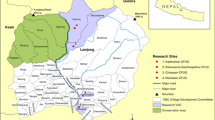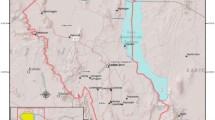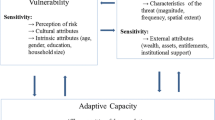Abstract
This paper builds on national- and regional-level vulnerability assessments by developing and applying a livelihood vulnerability index at the community and household scales to explore the nature of climate vulnerability. It provides innovative methodological steps in relation to livelihood assessment to identify the vulnerability of households and communities to drought. This will help to improve drought vulnerability assessments in Ghana and more widely as it shows extra information can be obtained from local-level vulnerability assessment that may be lacking in national- and regional-level analysis. The research employs quantitative and qualitative data collected through participatory methods, key informant interviews and a questionnaire survey with 270 households across 6 communities in two regions in Ghana. Results show that within the same agroecological zone, households and communities experience different degrees of climate vulnerability. These differences can be largely explained by socioeconomic characteristics such as wealth and gender, as well as access to capital assets. Results identify vulnerable households within resilient communities as well as more resilient households within vulnerable communities. These outliers are studied in detail. It is found that outlier households in vulnerable communities have an array of alternative livelihood options and tend to be socially well connected, enabling them to take advantage of opportunities associated with environmental and economic changes. To sustain and enhance the livelihoods of vulnerable households and communities, policymakers need to identify and facilitate appropriate interventions that foster asset building, improve institutional capacity as well as build social capital.




Similar content being viewed by others
References
Abson, D. J., Dougill, A. J. & Stringer, L. C. (2012). Using principal component analysis for information-rich socio-ecological vulnerability mapping in Southern Africa. Applied Geography. doi:10.1016/j.apgeog.2012.08.004.
Action-Aid. (2011). On the brink: Who’s best prepared for a climate change and hunger crisis? http://www.actionaid.org/publications/brink-whos-best-prepared-climate-and-hunger-crisis, 25th October, 2011.
Adger, W. N. (2000). Social and ecological resilience: Are they related? Progress in Human Geography, 24(3), 347–364.
Adger, W. N. (2003). Social capital, collective action, and adaptation to climate change. Economic Geography, 79(4), 387–404.
Adger, W. N., Dessai, S., Goulden, M., Hulme, M., Lorenzoni, I., Nelson, D. R., et al. (2009). Are there social limits to adaptation to climate change? Climatic Change, 93(3), 335–354.
Adger, W. N., & Kelly, P. M. (1999). Social vulnerability to climate change and the architecture of entitlements. Mitigation and Adaptation Strategies for Global Change, 4(3), 253–266.
Allison, E. H., Perry, A. L., Badjeck, M. C., Adger, W. N., Brown, K., Conway, D., et al. (2009). Vulnerability of national economies to the impacts of climate change on fisheries. Fish and Fisheries, 10(2), 173–196.
Antwi-Agyei, P., Fraser, E. D. G., Dougill, A. J., Stringer, L. C., & Simelton, E. (2012). Mapping the vulnerability of crop production to drought in Ghana using rainfall, yield and socioeconomic data. Applied Geography, 32, 324–334.
Barrett, C. B., Reardon, T., & Webb, P. (2001). Nonfarm income diversification and household livelihood strategies in rural Africa: Concepts, dynamics, and policy implications. Food Policy, 26(4), 315–331.
Bebbington, A. (1999). Capitals and capabilities: A framework for analyzing peasant viability, rural livelihoods and poverty. World Development, 27(12), 2021–2044.
Birkmann, J. (2007). Risk and vulnerability indicators at different scales: Applicability, usefulness and policy implications. Environmental Hazards, 7(1), 20–31.
Boko, M., Niang, I., Nyong, A., Vogel, C., Githeko, A., Medany, M., Osman Elasha, B., Tabo, R., & Yanda, P. (2007). Africa: In M. L. Parry, O. F. Canziani, J. P. Palutikof, P. J. van der Linden, & C. E. Hanson (Eds.), Climate change (2007): Impacts, adaptation and vulnerability. Contribution of working group II to the fourth assessment report of the intergovernmental panel on climate change (pp. 433–467). Cambridge: Cambridge University Press.
Brooks, N., Adger, W. N., & Kelly, P. M. (2005). The determinants of vulnerability and adaptive capacity at the national level and the implications for adaptation. Global Environmental Change Part A, 15(2), 151–163.
Butt, T. A., McCarl, B. A., & Kergna, A. O. (2006). Policies for reducing agricultural sector vulnerability to climate change in Mali. Climate Policy, 5(6), 583–598.
Carney, D. (1998). Sustainable rural livelihoods: What contributions can we make?. Nottingham: Russell Press Ltd.
Chambers, R. (1994). The origins and practice of participatory rural appraisal. World Development, 22(7), 953–969.
Chambers, R. & Conway, G. (1992). Sustainable rural livelihoods: Practical concepts for the 21st century.IDS Discussion Paper 296, Institute of Development Studies.
Eakin, H., & Bojorquez-Tapia, L. A. (2008). Insights into the composition of household vulnerability from multicriteria decision analysis. Global Environmental Change, 18(1), 112–127.
Ellis, F. (1998). Household strategies and rural livelihood diversification. The Journal of Development Studies, 35(1), 1–38.
Engle, N. L. (2011). Adaptive capacity and its assessment. Global Environmental Change, 21(2), 647–656.
EPA. (2003). National action programme to combat drought and desertification, Ghana Environmental Protection Agency, Ghana Government, Accra, Ghana.
Ericksen, P., Thornton, P., Notenbaert, A., Cramer, L., Jones, P. & Herrero, M. (2011). Mapping hotspots of climate change and food insecurity in the global tropics. Retrieved 10 January, 2012, from http://cgspace.cgiar.org/handle/10568/3826.
Eriksen, S. H., Brown, K., & Kelly, P. M. (2005). The dynamics of vulnerability: Locating coping strategies in Kenya and Tanzania. The Geographical Journal, 171(4), 287–305.
Fosu-Mensah, B. Y., Vlek, P. L. G., & MacCarthy, D. (2012). Farmers’ perception and adaptation to climate change: A case study of Sekyedumase district in Ghana. Environment, Development and Sustainability, 14, 495–505.
Fraser, E. D. G. (2007). Travelling in antique lands: Using past famines to develop an adaptability/resilience framework to identify food systems vulnerable to climate change. Climatic Change, 83(4), 495–514.
Fraser, E. D. G., Mabee, W., & Figge, F. (2005). A framework for assessing the vulnerability of food systems to future shocks. Futures, 37(6), 465–479.
Ghana Government. (2000). Population and housing census (2000). Accra, Ghana: Ghana Statistical Service.
Gibson, C. C., Ostrom, E., & Ahn, T. K. (2000). The concept of scale and the human dimensions of global change: A survey. Ecological Economics, 32(2), 217–239.
Hahn, M. B., Riederer, A. M., & Foster, S. O. (2009). The livelihood vulnerability index: A pragmatic approach to assessing risks from climate variability and change—a case study in Mozambique. Global Environmental Change, 19(1), 74–88.
Haines, A., Kovats, R. S., Campbell-Lendrum, D., & Corvalán, C. (2006). Climate change and human health: Impacts, vulnerability, and mitigation. The Lancet, 367(9528), 2101–2109.
Hesselberg, J., & Yaro, J. A. (2006). An assessment of the extent and causes of food insecurity in northern Ghana using a livelihood vulnerability framework. GeoJournal, 67(1), 41–55.
Hinkel, J. (2011). “Indicators of vulnerability and adaptive capacity”: Towards a clarification of the science–policy interface. Global Environmental Change, 21(1), 198–208.
Holling, C. S. (1973). Resilience and stability of ecological systems. Annual Review of Ecology and Systematics, 4, 1–23.
IPCC. (2007). Climate change 2007: Impacts, adaptation and vulnerability: contribution of working group II to the fourth assessment report of the IPCC. Cambridge: Cambridge University Press.
Krippendorff, K. (2004). Content analysis: An introduction to its methodology. Thousand Oaks: Sage Publications, Inc.
Leichenko, R. M., & O’Brien, K. L. (2002). The dynamics of rural vulnerability to global change: the case of southern Africa. Mitigation and Adaptation Strategies for Global Change, 7(1), 1–18.
Levia, D. F, Jr, & Page, D. R. (2000). The use of cluster analysis in distinguishing farmland prone to residential development: A case study of Sterling, Massachusetts. Environmental Management, 25(5), 541–548.
Lin, J. Y. (1991). Education and innovation adoption in agriculture: Evidence from hybrid rice in China. American Journal of Agricultural Economics, 73(3), 713–723.
Marschke, M. J., & Berkes, F. (2006). Exploring strategies that build livelihood resilience: A case from Cambodia. Ecology and Society, 11(1), 42.
Midgeley, S. J. E., Davies, R. A. G. & Chesterman, S. (2011). Climate risk and vulnerability mapping: status quo (2008) and future (2050) for Southern Africa: Synthesis Report, OneWorld Investments. South Africa.
Miller, F., Osbahr, H., Boyd, E., Thomalla, F., Bharwani, S., Ziervogel, G., et al. (2010). Resilience and vulnerability: Complementary or conflicting concepts. Ecology and Society, 15(3), 11.
Ministry of Food and Agriculture. (2007). Food and agriculture sector development policy. Accra: Ministry of Food and Agriculture.
Morse, S., & Fraser, E. (2005). Making dirty’nations look clean? The nation state and the problem of selecting and weighting indices as tools for measuring progress towards sustainability. Geoforum, 36(5), 625–640.
Moser, C. O. N. (1998). The asset vulnerability framework: Reassessing urban poverty reduction strategies. World Development, 26(1), 1–19.
Moser, C. & Satterthwaite, D. (2008). Towards pro-poor adaptation to climate change in the urban centres of low-and middle-income countries, International Institute for Environment and Development, Climate Change and Cities Discussion Paper 3. London.
Naab, J. B. & Koranteng, H. (2012). Using a gender lens to explore farmers’ adaptation options in the face of climate change: results of a pilot study in Ghana. Working Paper No.17, CGIAR Research Programme on Climate Change, Agriculture and Food Security. Nairobi, Kenya.
Osbahr, H., Twyman, C., Adger, W. N., & Thomas, D. S. G. (2010). Evaluating successful livelihood adaptation to climate variability and change in southern Africa. Ecology and Society, 15(2), 27.
Paavola, J. (2008). Livelihoods, vulnerability and adaptation to climate change in Morogoro, Tanzania. Environmental Science & Policy, 11(7), 642–654.
Pretty, J. (2003). Social capital and the collective management of resources. Science, 302(5652), 1912.
Pretty, J., & Ward, H. (2001). Social capital and the environment. World Development, 29(2), 209–227.
Reid, P., & Vogel, C. (2006). Living and responding to multiple stressors in South Africa–Glimpses from KwaZulu-Natal. Global Environmental Change, 16(2), 195–206.
Sallu, S. M., Suckall, N., & Reed, M. S. (2009). Participatory methods training in Malawi—Workshop manual. UK: University of Leeds Press.
Sallu, S. M., Twyman, C., & Stringer, L. C. (2010). Resilient or vulnerable livelihoods? Assessing livelihood dynamics and trajectories in rural Botswana. Ecology and Society, 15(4), 3.
Scoones, I. (1998). Sustainable rural livelihoods: A framework for analysis. Brighton: Institute of Development Studies.
Sen, A. K. (1981). Poverty and famines: An essay on entitlement and deprivation. Oxford: Clarendon Press.
Sen, A. (1999). Development as freedom. Oxford: Oxford University Press.
Simelton, E., Fraser, E. D. G., Termansen, M., Forster, P. M., & Dougill, A. J. (2009). Typologies of crop-drought vulnerability: An empirical analysis of the socio-economic factors that influence the sensitivity and resilience to drought of three major food crops in China (1961–2001). Environmental Science & Policy, 12(4), 438–452.
Smit, B., & Wandel, J. (2006). Adaptation, adaptive capacity and vulnerability. Global Environmental Change, 16(3), 282–292.
Thomas, D. S. G., Twyman, C., Osbahr, H., & Hewitson, B. (2007). Adaptation to climate change and variability: Farmer responses to intra-seasonal precipitation trends in South Africa. Climatic Change, 83(3), 301–322.
UNDP. (2007). Human Development Report 2007/2008: Fighting climate change: Human solidarity in a divided world., United Nations Development Programme. New York, USA.
Vincent, K. (2004). Creating an index of social vulnerability to climate change for Africa. Tyndall Center for Climate Change Research. Working Paper 56, 41.
Vincent, K. (2007). Uncertainty in adaptive capacity and the importance of scale. Global Environmental Change, 17(1), 12–24.
Walker, B., Gunderson, L., Kinzig, A., Folke, C., Carpenter, S., & Schultz, L. (2006). A handful of heuristics and some propositions for understanding resilience in social-ecological systems. Ecology and Society, 11(1), 13.
Weir, S. (1999). The effects of education on farmer productivity in rural Ethiopia. The Centre for the Study of African Economies Working Paper Series. Oxford: University of Oxford.
Wilbanks, T. J. (2007). Scale and sustainability. Climate Policy, 7(4), 278–287.
Woolcock, M. (2001). The place of social capital in understanding social and economic outcomes. Canadian Journal of Policy Research, 2, 11–17.
Yohe, G., & Tol, R. S. J. (2002). Indicators for social and economic coping capacity–moving toward a working definition of adaptive capacity. Global Environmental Change, 12(1), 25–40.
Zhang, X., Rockmore, M., & Chamberlin, J. (2007). A typology for vulnerability and agriculture in sub-Saharan Africa. Washington: International Food Policy Research Institute.
Ziervogel, G., Bharwani, S., & Downing, T. E. (2006). Adapting to climate variability: Pumpkins, people and policy. Natural Resource Forum, 30, 294–305.
Ziervogel, G., & Calder, R. (2003). Climate variability and rural livelihoods: Assessing the impact of seasonal climate forecasts in Lesotho. Area, 35(4), 403–417.
Acknowledgments
This study was funded by the Commonwealth Scholarships, UK and the International Foundation for Science (IFS). The authors gratefully acknowledge the constructive comments by Dr Susannah Sallu (University of Leeds) on an earlier draft of this paper. The authors would also like to thank the three anonymous reviewers for their insightful comments and suggestions.
Author information
Authors and Affiliations
Corresponding author
Rights and permissions
About this article
Cite this article
Antwi-Agyei, P., Dougill, A.J., Fraser, E.D.G. et al. Characterising the nature of household vulnerability to climate variability: empirical evidence from two regions of Ghana. Environ Dev Sustain 15, 903–926 (2013). https://doi.org/10.1007/s10668-012-9418-9
Received:
Accepted:
Published:
Issue Date:
DOI: https://doi.org/10.1007/s10668-012-9418-9




